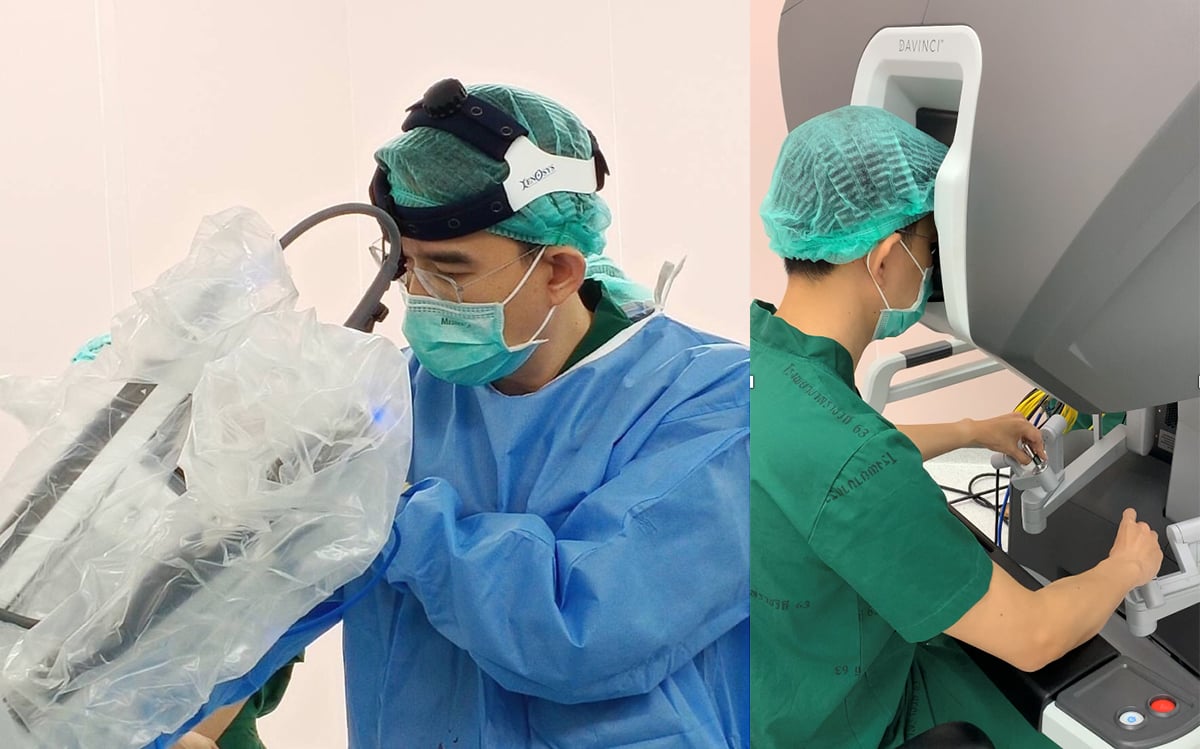Head and neck surgery is used to treat a wide range of Ear, Nose and Throat (ENT) conditions affecting the neck, mouth, throat, salivary glands and sinuses, as well as both non-cancerous, e.g. benign salivary gland tumors and benign thyroid nodules and malignant tumors located in the head and neck region, e.g. oral cancer, tonsil cancer and hypopharyngeal cancer. Medical advances in otolaryngology-head and neck surgery have accelerated the pace of changes, offering an amazing cooperation between surgeons and technology, through which surgeries reach high levels of precision and efficiency. A cutting-edge robotic system, the da Vinci Xi is designed to accommodate and seamlessly integrate a range of current technologies in surgical areas, including intraoperative imaging, advanced instruments, and anatomical access, enabling the surgeons to perform minimally invasive procedures in hard-to-reach areas, allowing the removal of cancerous tumors and tissues while preserving surrounding vital structures through small incisions. Indeed, the use of the da Vinci Xi is associated with less pain and faster recovery with an improved patient’s quality of life.
Advances in otolaryngology-head and neck surgery
After the diagnosis of ENT tumors has been made both benign and malignant ones, the surgeon along with the patient and family need to mutually design treatment planning. If surgery is considered the treatment of choice, it must be conducted as soon as possible before the condition severely progresses, causing other health related issues. As minimally invasive otolaryngology-head and neck surgery has emerged, endoscopic surgery has become a preferred treatment option for several conditions, resulting in highly satisfactory outcomes and improved quality of life. The da Vinci system is an advanced robotic technology designed to enable surgeons to perform a minimally invasive otolaryngology-head and neck surgery with enhanced surgical precision and safety. Robotic arms are capable of free movements of nearly 360° on seven axes, thereby improving access to anatomically challenging or hard-to-reach areas with a reduction in postoperative complications compared to conventional or open surgery.
What is the da Vinci Xi?
The da Vinci Xi is an advanced robotic surgical system using specialized technology that enhances the capabilities of surgeon’s hands. Controlled by a computer system, four surgical arms consisting of tiny instruments with wrists at the tip allow surgeons to perform procedures in difficult-to-reach or complex areas with precise movements, enhanced magnification and better dexterity within the deep and narrow confines in the head and neck region. Since surgeon’s expertise plays a critical role in successful surgery, a special high-definition camera attached helps provide magnified 3D views of the operating area, including vessels, tissues and nerves, leading to higher degree of surgical accuracy and patient’s safety. For every movement, the surgeon makes at the console standing next to the surgical arms and the da Vinci robot replicates every move inside patient’s body on a smaller scale. The surgeon has complete control during the entire procedure. In addition, built-in tremor-filtration eliminates the surgeon’s hand tremors to prevent involuntary movements, allowing more surgical accuracy. Moreover, robotic-assisted surgery using the da Vinci Xi has been deployed in otolaryngology-head and neck surgery due to smaller incisions, less pain, shortened operative time with faster recovery after surgery.

What are head and neck conditions that can be treated with the da Vinci Xi?
The da Vinci Xi robotic-assisted system has been adopted to carry out otolaryngology procedures to treat head and neck conditions, such as:
- Benign or non-cancerous tumors
- Benign tumors in the throat: Benign tumors in the throat are, for example, benign saliva gland tumors and benign nerve tumor. Despite they are non-cancerous, if left untreated, they might potentially enlarge, compressing adjoining structures in the throat. Compressive symptoms, such as difficulty swallowing, trouble breathing and loud snoring when sleeping often interfere with patients’ daily activities and impair their quality of life. More importantly, certain types of these benign tumors can turn to be cancer cells in the future. If surgery is indicated, robotic-assisted surgery using the da Vinci Xi enables the surgeon to reach the highly challenging area. In comparison to conventional or open surgery in which a large incision is required, robotic-assisted surgery substantially helps to minimize the chance of postoperative complications, allowing for a rapid recovery with quick return to daily life.
- Neck masses: Palpable neck masses are often the abnormal sign of patients visiting their ENT doctors. Some neck masses are present from birth (congenital neck masses) whereas some might develop later at some point. Consideration whether surgery is a preferred treatment option should be supervised and made by the surgeon. Robotic-assisted surgery using the da Vinci Xi is an alternative, yielding advantages of less pain and reduced complications with superior cosmetic benefits due to a hidden scar. This procedure is particularly recommended in most patients present with congenital neck masses.
- Malignant tumors
- Tonsil cancer: Tonsil cancer is induced by an abnormal growth of cells that forms in tonsils which are two oval-shaped pads in the back of the mouth. Tonsil cancer is sometimes attributed to the human papillomavirus or HPV. Common sign is the presence of a lump in the neck often accompanied with difficulty swallowing, a feeling that something is caught in the back of the throat and chronic pain in the neck. Tonsil cancer treatment options may include surgery, radiation or a combination of chemotherapy and radiation therapy, chiefly depending on its size and stage. To reach the best possible outcome, treatment plan needs to be discussed and made by the surgeon and the patient. Due to scarring or nerve damage, speech and swallowing therapy might be required after surgery. As a result of greater surgical precision with preserved surrounding structure particularly nerves retrieved from robotic-assisted surgery using the da Vinci Xi, patients usually experience less speech and swallowing impairment after surgery. Time for recuperation shortens and the patients are able to nearly resume to their normal life.
- Base of the tongue cancer: With similar etiologic cause to tonsil cancer, cancer of the base of the tongue is found in the back third of the tongue near the throat (pharynx). As its location poses an inadequate visualization, the patients usually notice abnormal lump when it is in progressing stages. Alarming signs are trouble swallowing, sensation of pain while swallowing, bleeding from oral cavity and the lump in the neck or throat. Treatment options, similar to tonsil cancer, are surgery, radiation and chemotherapy. Nevertheless, as the base of the tongue is situated all the way at the back of the tongue, it exceedingly challenges the surgeon to reach this area when compared to tonsil cancer. Hence, the da Vinci Xi might be an alternative option served with a better accessibility to hard-to-reach location. However, in advanced stage where cancer has spread to adjacent organs, surgery is no longer the treatment of choice. Radiation in combination with chemotherapy becomes a recommended choice. Treatment plan for each individual hinges on the expert specialists.
- Laryngeal cancer: Laryngeal cancer is cancer of the larynx or voice box containing the vocal cords. The condition is more common in men than in women. Most cancers that arises in the larynx begin on the mucosal surface, called squamous cell carcinoma. It may form in any of the three parts of the larynx: the supraglottis, glottis and subglottis. However, it is often found in the glottis, on the mucous membranes of the vocal cords. If left untreated, cancer cells can potentially spread and become life-threatening. Symptoms of laryngeal cancer are voice changes, such as chronic hoarseness, pain when swallowing or difficulty swallowing, choking, coughing up blood, difficulty breathing and lump (s) in the neck. The type of surgery is dependent on the stage of cancer. If caught in early stages, the surgery involves the removal of a portion of the larynx, known as partial laryngectomy. Nonetheless, if cancer has spread, surgery to remove the entire larynx (total laryngectomy) is often advised, leaving an inability to talk after surgery since the patients will no longer have vocal cords. Robotic-assisted surgery using the Da Vinci Xi enhances surgical precision and accuracy, enabling a better maneuvers and shorter operative time.
- Nasopharyngeal cancer: Nasopharyngeal cancer is more prevalent in men than it is in women. Abnormal cell growth starts in the upper part of the throat, behind the nose. Contributing factors to nasopharyngeal cancer are frequent and heavy consumption of alcohol, smoking and secondhand smoke, EBV (Epstein-Barr Virus) infection, consumption of salted fish and processed foods. Warning symptoms are lump or mass in the neck, nasal congestion, blood-stained sputum and chronic runny nose. The main treatment for nasopharyngeal cancer is radiation therapy. However, surgery using the da Vinci Xi might be occasionally recommended, particularly in patients who fail to respond to radiation.
What are advantages of the da Vinci Xi for minimally invasive otolaryngology-head and neck surgery?
The fourth generation of the da Vinci system yields benefits, including:
- Better accessibility: Robotic arms are capable of free movements of nearly 360° on seven axes, thereby improving access to anatomically challenging or hard-to-reach areas.
- More precise surgery: Surgery can be carried out efficiently since the robotic arm’s movements are highly precise with greater range of motion, ensuring that the maneuvers made by the surgeon are safe and precise in all angles.
- Accurate removal of tissues: Cancer cells and desired tissues can be accurately removed with adequate lymph node dissection while minimizing the chance of nerve damages.
- Improved visualization: A sophisticated camera provides magnified, high-definition views of the surgical area with a better visualization, resulting in less complications caused by damages to the surrounding areas.
- Faster recovery: Due to small incisions, patients often experience less pain, shorter hospital stay with a quick return to daily life.
- Improved survival rates: Higher degree in surgical precision helps to minimize postoperative complications and increase the survival rates of patients with certain head and neck cancers.









